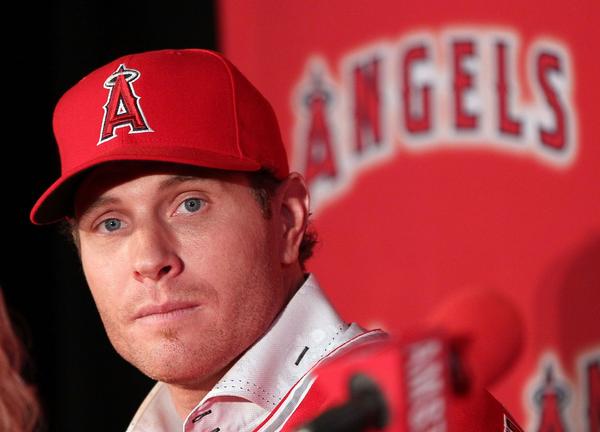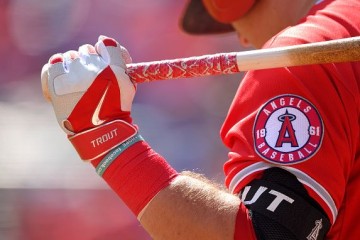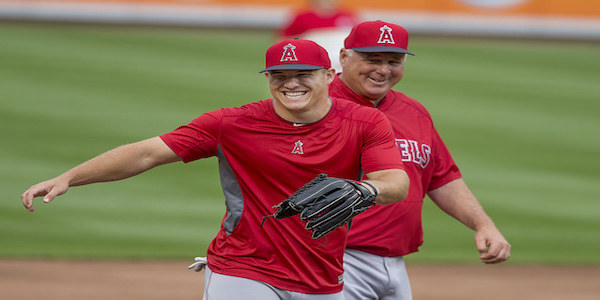2013 Fantasy Baseball, Hold or Fold: Josh Hamilton

It seemed like a match made in heaven. Pair Josh Hamilton with Albert Pujols, Mike Trout, and Mark Trumbo and you had the makings of an elite offensive force. The Angels certainly thought that when they gave Hamilton a five year deal for 125 million dollars. Though, as we have seen, the best laid plans of mice and men rarely ever work out as planned.
Some fantasy owners bought into the simplistic reasoning of Hamilton cashing in on a great offense and a team on the rise. Others have done it before. Albert Belle was supposed to mash with Frank Thomas. Heck, fantasy owners did it the year before with Albert Pujols. Yet, like with Pujols, signs of decay are there and that is why we often look at more advanced numbers when looking at players.
For those new to the hold and fold series, you should know I never look at current season numbers until we are at least six weeks into the season. 2013 data won’t tell us much beyond what we should already know. So, with Hamilton I will go from the more basic numbers and slowly peel back the onion until we reach the core of what is going on. Then, we can determine whether the early season slump is just a slump or something a little bit more.
|
AVG |
HR |
Runs |
RBI |
SB |
|
| 2008 |
.304 |
32 |
98 |
130 |
9 |
| 2009 |
.268 |
10 |
43 |
54 |
8 |
| 2010 |
.359 |
32 |
95 |
100 |
8 |
| 2011 |
.298 |
25 |
80 |
94 |
8 |
| 2012 |
.285 |
43 |
103 |
128 |
7 |
Basic numbers paint a decent enough picture most of the time. My artistic skills don’t go much beyond stick figures, but stick figures can still tell a decent story. Here, we have a guy that averages roughly 30 home runs and 100 RBIs a year. He’s capable of exploding in terms of average, but most of the time hovers between .280 and .300. That’s a decent enough player.
The problem with runs and RBI is that they are team dependent. Most people make the mistake of thinking that those numbers are based on skill. They are based more on opportunity than skill. Without looking at other numbers, we cannot know whether his 130 RBIs were based on an increase in opportunities or an increase in the rate of success when he had opportunities. That is where the second set of numbers come into play.
|
OBP |
SLG |
ISOpw |
ISOpa |
BABIP |
|
| 2008 |
.371 |
.530 |
.226 |
.067 |
.333 |
| 2009 |
.315 |
.426 |
.158 |
.047 |
.319 |
| 2010 |
.411 |
.633 |
.274 |
.062 |
.390 |
| 2011 |
.346 |
.536 |
.238 |
.048 |
.317 |
| 2012 |
.354 |
.577 |
.292 |
.069 |
.320 |
Many of you are familiar with isolated power (ISOpw) but most of you have not seen isolated patience (ISOpa). It is calculated the same way that isolated power is. You take OBP and subtract batting average. Most of the elite players tend to average between .080 and .100 in isolated patience. We see that Hamilton has never gotten there. A decent guess based on past performance would have him between .050 and .060. That’s simply not good and a bit worrisome for someone advancing in age.
Hamilton has made his money with his tremendous power numbers. A .200 isolated power number is considered good in this day and age. He has averaged a .268 ISO the last three seasons. That means that when he makes contact he tends to make it with authority. That would explain his high rate of line drives and better than average batting average on balls in play. That should continue for the most part, but the low on base skills are pointing towards a problem we will see very clearly in the next table.
|
SO% |
BB% |
Oswing% |
Contact% |
SWStr% |
|
| 2008 |
17.9 |
9.1 |
34.7 |
74.1 |
14.0 |
| 2009 |
21.6 |
6.6 |
36.0 |
72.2 |
15.5 |
| 2010 |
16.6 |
7.5 |
37.3 |
75.1 |
13.3 |
| 2011 |
17.3 |
7.2 |
41.0 |
74.6 |
13.6 |
| 2012 |
25.5 |
9.4 |
45.4 |
64.7 |
20.0 |
A high strike out rate by itself is not a huge problem. Most power hitters carry a bigger strikeout number because they are more selective and they tend to avoid the same kind of two strike approach that contact hitters prefer. However, that same selectivity that gets them into a lot of two strike counts also gets them into a lot of three ball counts. That means a walk rate normally north of ten percent. Hamilton has never been north of ten percent. In fact, his 9.4 percent in 2012 was as good as it gets for him.
The reverse is the low walk rate. That by itself is not a big deal, but we would all prefer hitters that can take a walk. Some hitters have gotten by for years with low walk and low strikeout rates. If you can hit plenty of line drives (or groundballs if you have speed), you can maintain a high batting average and a passable OBP with a low walk rate. As you might have guessed, a high strikeout rate and a low walk rate is the kiss of death.
Rules of thumb are not absolute, but a good rule of thumb in this regard is to have a strikeout to walk ratio of less than two to one. Hamilton does not do that and is threatening to go three to one. The anatomy of the problem can be seen in the next three numbers on the table. He is swinging at more and more balls outside the strike zone (Oswing). That leads to a lower overall contact rate as you can see in the table. The swinging strike rate is also an indication of the problem.
I wouldn’t expect his rates to be as bad as they were in 2012. Usually, we don’t expect to see dips that significant hold the following season. However, he is trending downward and those trends are probably one reason why the Rangers declined to offer more than three seasons. They are a sabermetrically minded organization and those organizations usually follow the numbers pretty closely. The Angels have not followed them as closely.
The long and short of it is that Hamilton is making less and less contact. The caveat is that few players make as much out of their contact as Hamilton does. So, he will still put up some numbers and do some damage, but he will not be an elite player for much longer. Pitchers have figured out that they can get him to chase and when that happens you won’t be a superstar for much longer. If you drafted Hamilton you are a better off keeping him unless you can find someone that will give you something close to his pre-season value.





